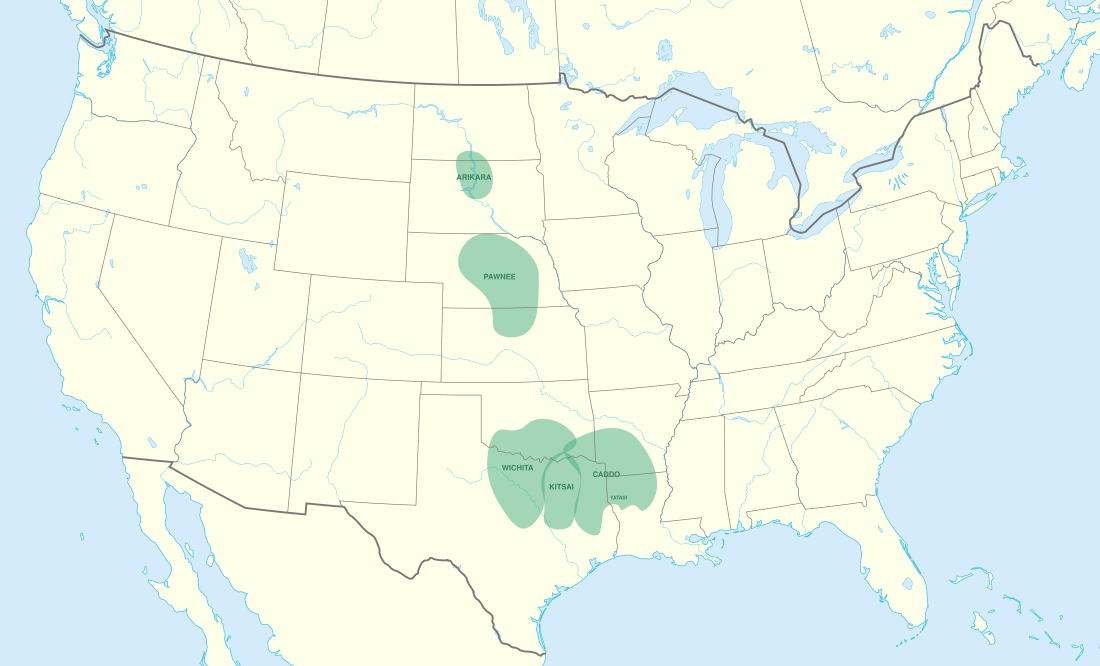Top Qs
Timeline
Chat
Perspective
Caddoan languages
Family of Native American languages From Wikipedia, the free encyclopedia
Remove ads
The Caddoan languages are a family of languages native to the Great Plains spoken by tribal groups of the central United States, from present-day North Dakota south to Oklahoma. All Caddoan languages are critically endangered, as the number of speakers has declined markedly due to colonial legacy, lack of support, and other factors.
Remove ads
Family division
Five languages belong to the Caddoan language family:
Caddo, Kitsai and Wichita have no speakers left. Kitsai stopped being spoken in the 19th century when its members were absorbed into the Wichita tribe. Wichita stopped being spoken in 2016, when the last native speaker of Wichita, Doris McLemore (who left recordings and language materials), died. Caddo stopped being spoken in 2025, when the last native speaker, Edmond Johnson, died.[1]
All of the remaining Caddoan languages spoken today are severely endangered. As of 2007, both the Pawnee and Arikara languages only had 10 speakers. Pawnee is spoken in Oklahoma by small numbers of tribal elders. Arikara is spoken on the Fort Berthold Reservation in North Dakota.
Prior to colonization and US expansion, speakers of Caddoan languages were more widespread. The Caddo, for example, lived in northeastern Texas, southwestern Arkansas, and northwestern Louisiana, as well as southeastern Oklahoma. The Pawnee formerly lived along the Platte River in what is now Nebraska.
Remove ads
Prehistory
Glottochronology is a controversial method of reconstructing, in broad detail, the history of a language and its relationships, though it may still provide useful insights and generalizations regarding a family's history. In the case of Proto-Caddoan, it appeared to have divided into two branches, Northern and Southern, more than 3000 years ago. (The division of the language implies also a geographic and/or political separation).
South Caddoan, or Caddo proper, evolved in north-eastern Texas and adjacent Oklahoma, Arkansas, and Louisiana. Other than Caddo, no daughter languages are known, but some unrecorded ones likely existed in the 16th and the 17th centuries.
Northern Caddoan evolved into several different languages. The language that became Wichita, with several different dialects, branched off about 2000 years ago. Kitsai separated from the Northern Caddoan stem about 1200 years ago, and Pawnee and Arikara separated 300 to 500 years ago.[2]
Remove ads
External relations
Adai, a language isolate from Louisiana is known only from a 275-word list collected in 1804, and may be a Caddoan language, however documentation is too scanty to determine with certainty.[3] Adjacent to the Caddo lived the Eyeish or Ais—not to be confused with the Ais of Florida—who also spoke a language that may have been related to Caddoan.[4]
Some linguists believe that the Caddoan, Iroquoian, and Siouan languages may be connected in a Macro-Siouan language family, but their work is suggestive and the theory remains hypothetical. Similar attempts to find a connection with the Algonquian languages have been inconclusive. There is insufficient evidence for linguists to propose a hypothetical Macro-Algonquian/Iroquoian language family.[5]
Reconstruction
Some Proto-Northern Caddoan reconstructions by Chafe (1979):[6]: 220
For Proto-Caddoan, Chafe (1979) reconstructs the following phonemes.[6]
- stops: /p t k/
- affricate: /ts/ ⟨c⟩
- spirant: /s/
- resonants: /w n r/ and /j/ ⟨y⟩
- laryngeals: /ʔ h/
- vowels: /i a u/
Remove ads
Vocabulary
Summarize
Perspective
Below is a list of basic vocabulary of Northern Caddoan languages from Parks (1979):[7]
Remove ads
Notes
Further reading
External links
Wikiwand - on
Seamless Wikipedia browsing. On steroids.
Remove ads

